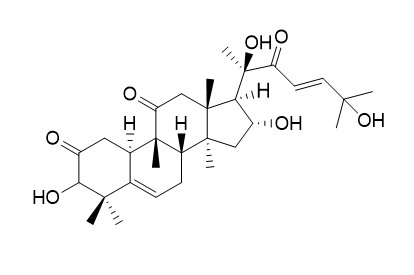Isocucurbitacin D
Isocucurbitacin D showed a cytotoxic effect with disruption of target protein cofilin.
Isocucurbitacin D exhibited the highest activities of improved the LDL uptake rate.Isocucurbitacin D dose-dependently increased LDLR protein levels and decreased PCSK9 protein levels.
Inquire / Order:
manager@chemfaces.com
Technical Inquiries:
service@chemfaces.com
Tel:
+86-27-84237783
Fax:
+86-27-84254680
Address:
1 Building, No. 83, CheCheng Rd., Wuhan Economic and Technological Development Zone, Wuhan, Hubei 430056, PRC
Providing storage is as stated on the product vial and the vial is kept tightly sealed, the product can be stored for up to
24 months(2-8C).
Wherever possible, you should prepare and use solutions on the same day. However, if you need to make up stock solutions in advance, we recommend that you store the solution as aliquots in tightly sealed vials at -20C. Generally, these will be useable for up to two weeks. Before use, and prior to opening the vial we recommend that you allow your product to equilibrate to room temperature for at least 1 hour.
Need more advice on solubility, usage and handling? Please email to: service@chemfaces.com
The packaging of the product may have turned upside down during transportation, resulting in the natural compounds adhering to the neck or cap of the vial. take the vial out of its packaging and gently shake to let the compounds fall to the bottom of the vial. for liquid products, centrifuge at 200-500 RPM to gather the liquid at the bottom of the vial. try to avoid loss or contamination during handling.
Acta horticulturae2017, 1158:257-268
J Chromatogr B Analyt Technol Biomed Life Sci. 2017, 1064:115-123
Environ Toxicol.2021, 36(9):1848-1856.
J Korean Soc Food Sci Nutr2023, 52(7): 750-757
Saudi Pharm J2020, 10.1016
Front Pharmacol.2018, 9:236
Chemical Engineering Journal2024, 500:157110
Plant Direct.2021, 5(12):e372.
Biol Pharm Bull.2023, 46(2):245-256.
Plants (Basel).2021, 10(12):2795.
Related and Featured Products
J Nat Prod., 2020 Dec 24;83(12):3536-3544.
Lipid-Lowering Activities of Cucurbitacins Isolated from Trichosanthes cucumeroides and Their Synthetic Derivatives[Pubmed:
33269591]
In the ongoing efforts to discover natural cholesterol-lowering compounds, dihydrocucurbitacin B, isolated from Trichosanthes cucumeroides roots, was found to promote LDL uptake by upregulating LDLR protein in a PCSK9-dependent process. In this study, an in-depth investigation of T. cucumeroides roots afforded 27 cucurbitacins (1-27), including seven new cucurbitacins (1-7), and their structures were elucidated by spectroscopic data analyses. In order to gain insight into their structure-activity relationship, cucurbitacin derivatives (B1-11 and DB1-11) were synthesized. Evaluation of lipid-lowering activities of these cucurbitacins by an LDL uptake assay in HepG2 cells revealed that most of the compounds improved the LDL uptake rate, among which hexanorIsocucurbitacin D (6) and Isocucurbitacin D (21) exhibited the highest activities (rates of 2.53 and 2.47, respectively), which were comparable to that of the positive control, nagilactone B (rate of 2.07). According to a mechanistic study by Western blot analysis, compounds 6 and 21 dose-dependently increased LDLR protein levels and reduced PCSK9 protein levels, representing promising new lipid-lowering drug candidates.
Toxins (Basel). 2022 Mar 16;14(3):212.
Analysis of Active Compounds Using Target Protein Cofilin-Cucurbitacins in Cytotoxic Plant Bryonia cretica[Pubmed:
35324709]
We examined a two-step target protein binding strategy that uses cofilin as the target protein to analyze the active constituents in Bryonia cretica. In the first step, we prepared the target protein, and used it to analyze the compounds binding to it in the second step. We used the methanolic extract of B. cretica as a library of possible active compounds. We conducted LC-MS analysis using information from our previous study. The peaks in the HPLC profile were identified as cucurbitacin D, Isocucurbitacin D, and cucurbitacin I. As far as we know, there is no known study of the activity of Isocucurbitacin D in this research field. Therefore, we examined the effects of Isocucurbitacin D on cell proliferation and cofilin protein in human fibrosarcoma cell line HT1080 to confirm the effectiveness of this strategy. The cytotoxicity assay, the fibrous/globular actin ratio assay, and the immunoblotting analysis revealed that Isocucurbitacin D showed a cytotoxic effect with disruption of target protein cofilin. The target protein binding strategy is a direct and straightforward method for finding new drug seeds from crude sources, such as natural plant extracts.
Zhongguo Zhong Yao Za Zhi . 2011 May;36(9):1193-1197.
[Studies on chemical constituents in roots of Helicteres angustifolia][Pubmed:
21842648]
Objective: To study the chemical constituents of the roots of Helicteres angustifolia.
Method: The compounds were isolated and purified by column chromatographic methods on silica gel, Sephadex LH-20, ODS and preparative HPLC. Their structures were elucidated on the basis of physicochemical properties and spectral data.
Results: Fourteen compounds were isolated from this plant. Their structures were identified as methyl helicterate(1),3-acetoxybetulin(2),3beta-acetoxy-27-(p-hydroxyl)benzoyloxylup-20(29)-en-28-oic acid methyl ester(3),3beta-acetoxy-27-benzoyloxylup-20(29)-en-28-oic acid(4),3beta-acetoxybetulinic acid(5),pyracrenic acid(6),cucurbitacin D(7),cucurbitacin B(8),Isocucurbitacin D(9),3beta-acetoxy-27-[(4-hydroxybenzoyl)oxy]olean-12-en-28-oic acid methyl ester (10),beta-sitosterol(11),2alpha,7beta,20alpha-trihydroxy-3beta,21-dimethoxy-5-pregnene(12), hexadecanoic acid(13), and daucosterol(14), respectively.
Conclusion: Compounds 5,8,9,13, 14 were isolated from this plant for the first time.
Yakugaku Zasshi . 1989 Apr;109(4):265-270.
[Studies on the constituents of trichosanthes root. III. Constituents of roots of Trichosanthes bracteata Voigt][Pubmed:
2760813]
From the fresh roots of Trichosanthes bracteata Voigt., the following substances were identified: methyl palmitate, palmitic acid, suberic acid, alpha-spinasterol, stigmast-7-en-3 beta-ol, alpha-spinasterol 3-O-beta-D-glucopyranoside, stigmast-7-en-3 beta-ol 3-O-beta-D-glucopyranoside, glyceryl 1-palmitate, glyceryl 1-stearate, bryonolic acid, cucurbitacin B, isocucurbitacin B, 3-epi-isocucurbitacin B, 23,24-dihydrocucurbitacin B, 23,24-dihydroisocucurbitacin B, 23,24-dihydro-3-epi-isocucurbitacin B, cucurbitacin D, Isocucurbitacin D and D-glucose. This root contains more than 6 times cucurbitacin of the root of T. kirilowii Maxim. var. japonicum Kitam.



